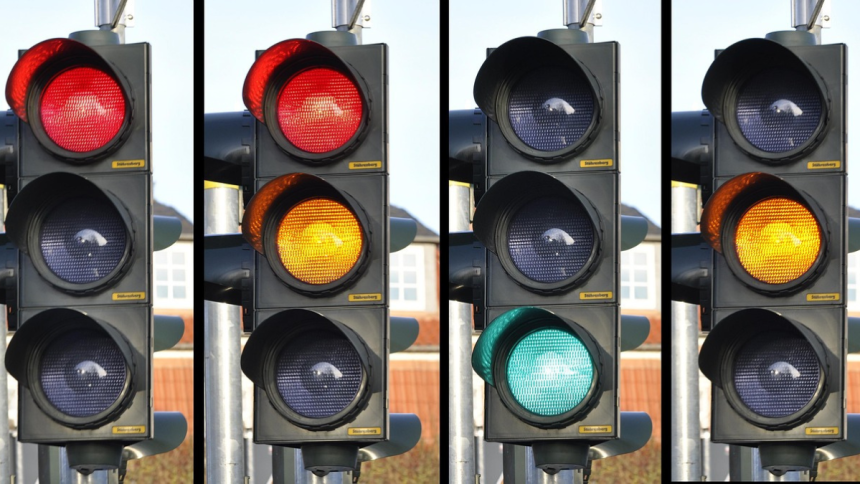A yellow light at an intersection means drivers need to slow down and get ready to stop. But sometimes, people speed up instead, trying to make it through before the light turns red. Whether it’s legal to go through a yellow light depends on traffic laws, and these can be different depending on where you are. Some places allow it if stopping suddenly would be unsafe, while others see it as risky driving that could lead to a fine.
Drivers need to understand the rules, so they know when it’s okay to continue and when they should stop. Making the wrong choice can lead to accidents or tickets. Drivers also have to consider things like how fast they’re going, the road conditions, and how much time they have before the light turns red.
Understanding Traffic Laws For Yellow Lights
Traffic lights are one of the most important systems for keeping roads safe. Red means stop, and green means go. But yellow is where things get complicated. Some drivers treat a yellow light as a warning to slow down, while others see it as an invitation to hurry through before it turns red. This difference in reaction can lead to confusion and accidents, making it essential to understand traffic laws regarding yellow lights.
In most places, a yellow light signals that the green phase is ending, and drivers should prepare to stop. The expectation is that drivers will slow down and come to a halt unless they’re already too close to the intersection to stop safely. However, the exact rules vary depending on local laws.
Some areas allow drivers to proceed if they’re already in the intersection when the light turns yellow, while others may issue fines if it seems like they intentionally sped up to avoid stopping.
The challenge with yellow lights is that they require quick decision-making. Drivers must assess their speed, distance from the intersection, and traffic conditions in a matter of seconds. Misjudging the timing can result in entering the intersection just as the light turns red, increasing the risk of collisions.
Many cities use traffic cameras to monitor intersections, and these devices capture drivers running red lights. Some states even issue fines for those who misinterpret a yellow light. Understanding the laws in your area helps prevent confusion and ensures you’re making legal and safe choices on the road.
When Is It Legal to Proceed Through a Yellow Light
One of the most common questions drivers have is whether they’re allowed to run a yellow light. The answer isn’t always clear, as different states have different laws, but the basic rule is that drivers should slow down when they see a yellow light and prepare to stop. The question then becomes, when is it legal to continue through?
The key factor in deciding whether running a yellow light is legal is safety. If a driver is too close to the intersection to stop without causing a sudden braking hazard, they may legally continue. However, this doesn’t mean speeding up to beat the red light is acceptable. If a driver is far enough back to safely stop, they should do so rather than trying to rush through.
Many states have laws stating that a driver can legally enter an intersection while the light is still yellow, but must clear the intersection before it turns red. This prevents cars from being stuck in the middle of the road after the light has changed, which can cause dangerous situations.
On the other hand, some states have stricter rules that consider running a yellow light a form of reckless driving. In these places, drivers are expected to stop when they see a yellow light unless doing so would put them in immediate danger. Understanding the legal expectations in your area helps avoid fines and accidents. It’s always better to err on the side of caution, as making the wrong decision can have serious consequences.
Risks and Consequences of Running a Yellow Light
Ignoring the cautionary nature of a yellow light can lead to serious consequences. One of the biggest risks of running a yellow light is miscalculating the timing. Drivers often assume they have enough time to cross the intersection before the light turns red, but slight errors can lead to dangerous situations.
Unfortunately, intersections are among the most common places for accidents to happen. When a driver speeds through a yellow light instead of stopping, they risk colliding with cars turning or crossing from another direction. These crashes, known as T-bone accidents, can be severe and cause major damage or injuries.
Beyond accidents, legal consequences can also follow. Many cities have traffic cameras installed at intersections that automatically issue tickets for violations. If a driver misjudges a yellow light and enters the intersection just as it turns red, they might receive a fine in the mail.
Liability is another concern. If a driver runs a yellow light and causes an accident, they may be found at fault. Insurance companies and law enforcement will assess whether the driver had time to stop and chose not to. If they’re found responsible, they may face increased insurance costs or legal penalties.
How Different States Handle Yellow Light Violations
Since traffic laws are determined at the state level, rules regarding yellow lights can differ depending on where you are. Some states give drivers more flexibility, allowing them to proceed through a yellow light as long as they entered the intersection before it turned red. Others treat running a yellow light as risky behavior and may issue fines for doing so.
In states that rely on traffic cameras, automated systems capture violations based on whether a car enters the intersection before or after the light changes. These cameras mostly focus on red-light violations, but they can also catch drivers who entered the intersection on yellow but failed to clear it in time.
The penalties for running a yellow light vary. Some states treat it as a minor traffic violation with a small fine, while others impose penalties similar to running a red light. Drivers might receive a ticket, points on their license, or increased insurance rates.
If a driver gets a ticket for running a yellow light, they may be able to challenge it in court. If they can prove that stopping would have been unsafe or that they had already entered the intersection before the light changed, they may have the charge dismissed.
Understanding how yellow light violations are handled in different states helps drivers stay informed and avoid trouble. Checking local traffic laws ensures that drivers know what’s expected of them and what penalties they could face if they make the wrong decision.
Steps to Take If You Get Into a Traffic Light Accident
Getting into an accident at a traffic light can be shocking and confusing. Whether it was caused by someone running a yellow light or another mistake, knowing the right steps to take can make a big difference in handling the situation smoothly.
The priority after any type of accident is safety. If anyone is injured, calling for medical help should come before anything else. Even if injuries seem minor, seeking medical attention is always a good idea to rule out hidden problems.
After ensuring safety, calling the police is the next step. An official report will document what happened, which can be useful for insurance claims and legal matters. If the accident was caused by someone running a yellow light, officers may determine who is at fault.
Taking pictures and gathering details is also helpful. Photos of the intersection, traffic signals, vehicle damage, and skid marks can provide important evidence. Witness statements can also strengthen your case if there’s a disagreement about what happened.
Insurance claims and legal concerns come next. Filing a claim helps cover costs for vehicle repairs and medical bills. If there’s a dispute over responsibility, legal guidance may be needed to protect your rights. Getting an attorney involved early in the process can be beneficial as they guide you on how to protect your rights and any legal actions you need to take to secure compensation.
Tips for Safe Decision-Making at Yellow Lights
Making the right choice at a yellow light can prevent accidents and legal trouble. The safest approach is to slow down and prepare to stop, rather than rushing through. A useful tip is to pay attention to how long a light has been green.
If it has been green for a while, the driver can anticipate that it will turn yellow soon and prepare accordingly. Driving at a steady speed also helps. If a driver is going too fast, stopping suddenly becomes harder, leading to mistakes. Keeping to the speed limit and watching for signals makes it easier to react.
Avoiding distractions near intersections is another key factor. Checking a phone or adjusting controls can delay reaction time and make it harder to judge the timing of a yellow light. Staying focused ensures better decision-making. Traffic lights exist to keep roads safe. Drivers who respect yellow lights and make careful choices can prevent accidents and avoid unnecessary penalties.
Lynn Martelli is an editor at Readability. She received her MFA in Creative Writing from Antioch University and has worked as an editor for over 10 years. Lynn has edited a wide variety of books, including fiction, non-fiction, memoirs, and more. In her free time, Lynn enjoys reading, writing, and spending time with her family and friends.















